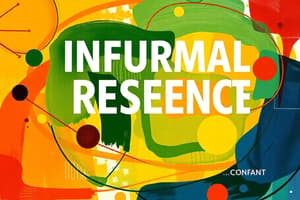Podcast
Questions and Answers
What was a primary ethical violation in the Tuskegee Syphilis Study?
What was a primary ethical violation in the Tuskegee Syphilis Study?
- Participants were promised health care but received none. (correct)
- Participants were paid for their involvement.
- The research was conducted without a scientific basis.
- Participants were fully informed about the study.
Which principle is included in the Nuremberg Code regarding research risks?
Which principle is included in the Nuremberg Code regarding research risks?
- All potential risks must be disclosed to participants.
- Participants must be monitored for physical and mental suffering.
- The risk of participation should never exceed the potential benefits. (correct)
- Only reputable sponsors can conduct research.
What action was taken by Dr. Chester Southam in 1963 that raised ethical concerns?
What action was taken by Dr. Chester Southam in 1963 that raised ethical concerns?
- He published false results in a medical journal.
- He injected geriatric patients with live cancer cells without consent. (correct)
- He withheld medical treatment from participants.
- He conducted unauthorized experiments on healthy individuals.
Which guideline from the Nuremberg Code emphasizes the importance of informed consent?
Which guideline from the Nuremberg Code emphasizes the importance of informed consent?
What principle was highlighted by the Declaration of Helsinki regarding experimental procedures?
What principle was highlighted by the Declaration of Helsinki regarding experimental procedures?
Which issue related to ethical research was exemplified by Stanley Milgram's experiments?
Which issue related to ethical research was exemplified by Stanley Milgram's experiments?
What is a major limitation of the Nuremberg Code?
What is a major limitation of the Nuremberg Code?
What type of research focuses on describing how things are rather than explaining why they are?
What type of research focuses on describing how things are rather than explaining why they are?
Which of the following types of research involves measuring variables without manipulation?
Which of the following types of research involves measuring variables without manipulation?
What is the range for a small correlation coefficient according to the general rules for reporting correlations?
What is the range for a small correlation coefficient according to the general rules for reporting correlations?
If a correlation coefficient (r) is 0.219, how strong is this relationship considered?
If a correlation coefficient (r) is 0.219, how strong is this relationship considered?
What does the coefficient of determination (r²) represent?
What does the coefficient of determination (r²) represent?
What is one principle related to the ethical conduct of human research?
What is one principle related to the ethical conduct of human research?
What is indicated by a negative relationship between two variables?
What is indicated by a negative relationship between two variables?
What problem arises from not being able to ascertain the true cause of a relationship between two variables?
What problem arises from not being able to ascertain the true cause of a relationship between two variables?
Which of the following is NOT a component of ethical approval for research involving humans?
Which of the following is NOT a component of ethical approval for research involving humans?
What does the principle of 'Replacement' refer to in the use of animals for research?
What does the principle of 'Replacement' refer to in the use of animals for research?
Diederik Stapel was suspended due to misconduct involving which of the following?
Diederik Stapel was suspended due to misconduct involving which of the following?
What is the primary goal of correlational research?
What is the primary goal of correlational research?
Which scenario exemplifies a conflict of interest?
Which scenario exemplifies a conflict of interest?
What is considered a breach in the context of research misconduct?
What is considered a breach in the context of research misconduct?
Which of the following actions may be required when investigating a complaint of research misconduct?
Which of the following actions may be required when investigating a complaint of research misconduct?
What is the primary goal in the supervision of research trainees?
What is the primary goal in the supervision of research trainees?
What is the aim of the principle of 'Refinement' regarding animal research?
What is the aim of the principle of 'Refinement' regarding animal research?
What must researchers do when they have a potential conflict of interest?
What must researchers do when they have a potential conflict of interest?
Flashcards are hidden until you start studying
Study Notes
Ethics in Research
- The Tuskegee Syphilis Study (1932-1972) involved 600 African-American agricultural workers who were promised healthcare as an incentive.
- Participants were not diagnosed, advised, treated, or cured for syphilis, despite the availability of penicillin by 1947.
- 128 participants died during this study.
Nuremberg Code (1947)
- The Nuremberg Code outlines 10 guidelines for the ethical treatment of human research participants.
- These guidelines were established in response to the atrocities committed during the Nazi regime.
- These guidelines are not legally binding.
Unethical Research Practices
- Dr. Chester Southam (1963) injected geriatric hospital patients with live liver cancer cells without their informed consent.
- Stanley Milgram (1963) conducted a study where participants were led to believe they were administering shocks, inducing psychological distress and raising ethical concerns about deception and informed consent.
Declaration of Helsinki (1964)
- This document sets ethical principles for medical research involving human subjects.
- It emphasizes the importance of independent review committees to evaluate research protocols.
Australian Code for the Responsible Conduct of Research
- Provides a framework for ethical research practices within universities and public sector institutions.
- Covers various aspects of research conduct, including data management, supervision, publication, authorship, peer review, conflict of interest, and collaborations.
National Statement on Ethical Conduct in Human Research
- Outlines standards for the design, review, and conduct of human research.
- Aims to promote ethical human research that respects and protects participants while fostering research that benefits the community.
- Ethical approval is mandatory for any research involving human participants.
- This includes surveys, interviews, focus groups, psychological testing, medical treatment, observation, access to personal documents, collection of bodily materials, and access to personal information.
Animal Research
- The use of live vertebrate animals in research requires ethical approval.
- The Australian Code of Practice for the Care and Use of Animals for Scientific Purposes outlines principles for responsible animal research.
- These principles include: Replacement (using alternative methods whenever possible), Reduction (minimizing the number of animals used), and Refinement (minimizing pain, suffering, and distress).
Conflict of Interest
- A conflict of interest arises when financial or personal considerations have the potential to compromise scientific or professional conduct.
- Examples include researchers benefiting financially from a specific research outcome, researchers receiving undisclosed payments, peer reviewers favoring research similar to their own work, or personal relationships between researchers and participants.
Research Misconduct
- A "breach" refers to deviations from the Australian Code for the Responsible Conduct of Research.
- Complaints of research misconduct require a response that may involve investigation, inquiry, and remedial actions.
- Research misconduct occurs if it involves all of the following: an alleged breach of the Australian Code, deliberation or recklessness, and serious consequences.
- Research misconduct includes fabrication, falsification, plagiarism, deception, failure to declare or manage a serious conflict of interest.
- Diederik Stapel, a Dutch social psychologist, was suspended for fabricating and manipulating data, leading to the retraction of at least 57 publications.
Research Strategies
Descriptive Research
- Aims to describe how things are, rather than explaining why they are.
- Often uses observational and survey research.
- Examples: What is the typical number of hours spent studying each week?
Correlational Research
- Goal is to describe the strength and direction of relationships between two or more variables.
- It measures variables but doesn’t manipulate them.
- Allows for predictions but cannot establish cause-and-effect.
- Relationships can be positive (both variables change in the same direction), negative (variables change in opposite directions), linear, and/or non-linear.
Pearson’s Correlation
- A statistical method used to measure the strength and direction of a linear relationship between two variables.
- Provides a correlation coefficient (r) which indicates the strength and direction of the relationship.
- The coefficient of determination (r2) indicates the proportion of variation in one variable that is accounted for by the other.
Terms to Use in Correlational Research
- Association
- Relation
- Correlation
- Prediction
Experimental Research
- Aims to identify cause-and-effect relationships by manipulating independent variables and measuring dependent variables.
- Requires four key elements: manipulation, measurement, control, and comparison.
Between-Subjects Design
- Different participants are assigned to each treatment condition.
- Vulnerable to individual difference threats to validity, but not time-related threats.
Within-Subjects Design
- The same participants are exposed to all treatment conditions.
- Not vulnerable to individual differences threats to validity, but vulnerable to time-related threats.
Extraneous Variables
- Variables other than the independent and dependent variables in a study.
- They can become confounding variables if they influence the dependent variable.
Confounding Variables
- Change systematically with the independent variable, influencing the dependent variable, making it difficult to determine the true effect of the independent variable.
Control Strategies
- Holding a variable constant: Reduces the possibility of a variable becoming confounding by restricting its range.
- Matching: Balancing the levels of a variable across treatment conditions to ensure they are equivalent (e.g., using counterbalancing or ensuring equal representation across conditions).
- Randomization: Utilizes random processes to avoid systematic relationships between variables, reducing the influence of extraneous variables.
Studying That Suits You
Use AI to generate personalized quizzes and flashcards to suit your learning preferences.




